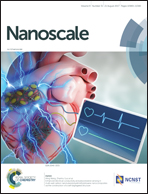Control of targeting ligand display by pH-responsive polymers on gold nanoparticles mediates selective entry into cancer cells†
Abstract
Selective targeting of cells for intracellular delivery of therapeutics represents a major challenge for pharmaceutical intervention in disease. Here we show pH-triggered receptor-mediated endocytosis of nanoparticles via surface ligand exposure. Gold nanoparticles were decorated with two polymers: a 2 kDa PEG with a terminal folate targeting ligand, and a di-block copolymer including a pH-responsive and a hydrophilic block. At the normal serum pH of 7.4, the pH-responsive block (apparent pKa of 7.1) displayed a hydrophilic extended conformation, shielding the PEG-folate ligands, which inhibited cellular uptake of the nanoparticles. Under pH conditions resembling those of the extracellular matrix around solid tumours (pH 6.5), protonation of the pH-responsive polymer triggered a coil-to-globule polymer chain contraction, exposing folate residues on the PEG chains. In line with this, endocytosis of folate-decorated polymer-coated gold nanoparticles in cancer cells overexpressing folate receptor was significantly increased at pH 6.5, compared with pH 7.4. Thus, the tumour acidic environment and high folate receptor expression were effectively exploited to activate cell binding and endocytosis of these nanoparticles. These data provide proof-of-concept for strategies enabling extracellular pH stimuli to selectively enhance cellular uptake of drug delivery vectors and their associated therapeutic cargo.



 Please wait while we load your content...
Please wait while we load your content...